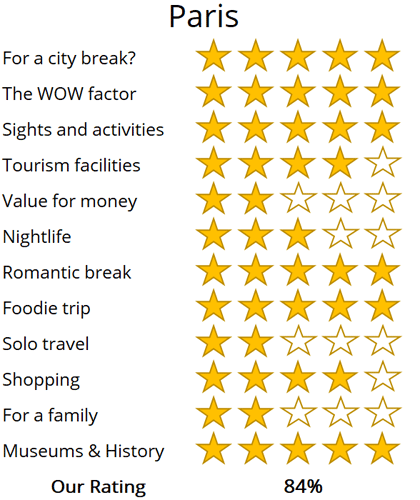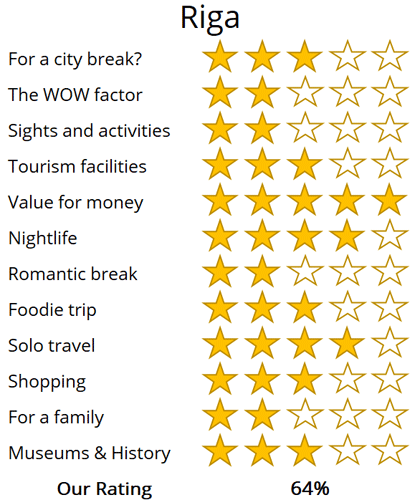WhereToGoForMyHoliday.com
The best destination comparison site!
WhereToGoForMyHoliday.com
The best destination comparison site!
Paris or Riga, which is better for your holiday in 2024?
Paris and Riga both offer unique and enticing experiences, but which one should you choose for your city break or holiday?
We understand your dilemma. There is an abundance of travel guides for both cities, but few actually comparing them, and advising you which is the better for your trip.
This article will provide our unbiased and independent views of Riga and Paris, hopefully making your choice that little easier.
The article is structured into several sections, each of which can be directly accessed through the following links:
• Introduction to the cities
• Scores and ratings
• Which one should I, friends, or family visit?
• When to visit and weather
• Who is the city suited for?
• The perfect 48hours (with map)
• Tourism details (where to stay? airport details?)
Introduction to Paris and Riga
Paris is famed as the capital of Romance, the epicentre of French culture and grand European art, and the home of iconic monuments like the Eiffel Tower. There's no question that it's an amazing city to explore.
Everywhere you go along the Seine River it seems like there's a world-class museum or gallery beckoning. But Paris can also be overwhelming, not to mention downright gritty in some parts.
The history here goes back to the Celtic tribes of the 400s BC. But it was the 7th-century fortifications on the Île de la Cité that went on to form the medieval kernel of the town.
The capital still radiates out from that, with bohemian neighborhoods along the Canal Saint-Martin, stereotypically Parisian cafes and cobbled streets in Montmartre, and enthralling cultural and foodie attractions throughout other arrondissements (areas).
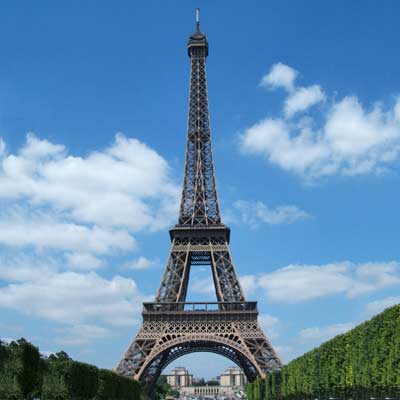
There is no more famous sight in Paris, or possibly the world than the Eiffel Tower
Riga is a cool and collected Baltic capital Bridging both sides of the Daugava River estuary, its laid-back districts effortlessly flit from elegant Art Nouveau to stoic northern cottages built from wood.
But it's the Old Town area that really draws the eye. That's a web of cobbled alleys and hidden squares. Onion domes and Gothic belfries loom overhead in those parts, and hearty Latvian taverns slosh with beers and burst with dumplings in cellars beneath the flagstones.
Be warned that Riga has developed a reputation for stag and hen do weekending. If you travel during the summer, you're likely to encounter at least one group of boozed-up Brits.
But that shouldn't put you off. There are enough craft beer joints, bohemian cafes, and restaurants to go around. What's more, the old guild houses and haunting churches can balance the experience out with a dollop of culture and history.
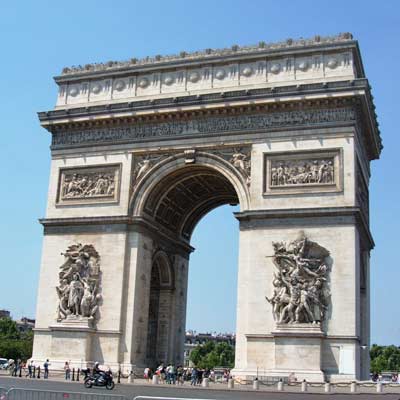
The Arc de Triomphe, constructed as a memorial to the soldiers who perished in the Napoleonic Wars and French Revolution

Riga castle stands along the Daugava River
Paris vs Riga: City Ratings
Summary
Where would I journey for a personal escape?
Paris
Where would I send my parents for a memorable visit?
Paris
Where's the ideal destination for my adventurous 19-year-old cousin?
Riga
Where should my food-obsessed friend indulge their culinary passions?
Paris
Note: The above comparisons are weather-independent and are based on travel during the most opportune times of the year. Details about the ideal travel seasons are elaborated upon later in this article.
In the sections that follow, you'll find a comprehensive comparison between these two fascinating cities. This includes recommendations on the duration of stay, the best times to visit, and tailored 48-hour itineraries for each city.
The final segment delves into practicalities for your travels, such as the best airport to fly into, the optimal districts for your accommodation, and insider tips, for when you come to explore the city.
We hope that you find all of this information useful, in planning your next exciting trip!
Destination details
How long to spend each city?
Riga might be the largest of the three Baltic capitals, but it's still a relatively small city. You can get from end to end in less than 40 minutes in the car, while the districts that are of interest to travellers are all within walking distance of each other.
That helps if you're only planning a short weekend away. Fly-in, fly-out city breaks are totally doable. In fact, a couple of days is what the majority of travellers come for.
If you want to explore for longer, you might want to come during the summertime. Not only can the winters here get downright cold (more on that later), but Riga is close to the some of the most celebrated beach resorts on the whole Baltic coast.
Paris could take a lifetime to explore completely. This is a living, breathing, sprawling capital city, which means even the locals can be surprised at the new cafes, bistros, and cultural events that come and go. For travellers, at least three days is a good idea.
That's probably just enough to see the mainstay sights and hop into the Louvre to catch a glimpse of the Mona Lisa. Trips to explore outer arrondissements and sample Paris's pumping nightlife should probably be between four days and a whole week, with more extensions needed if you want to hit the Loire Valley for wine tasting.

The skyline of central Riga, with Riga cathedral at the centre
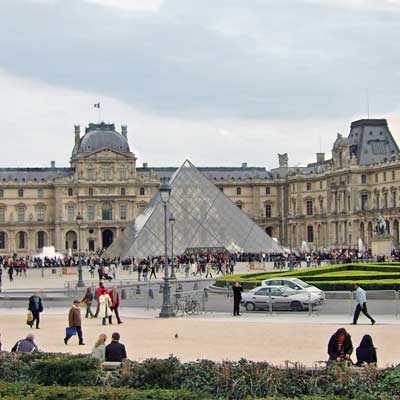
The Louvre with its distractive glass pyramid
The Baltic summers are a tamer version of the warm season in the south of the continent. It's pleasant here when the temperature squeezes into the low 20s. Then, Riga goes al fresco in earnest.
The cafes on the main squares in the Riga Old Town buzz with life and chatter. There are students and backpackers sharing stories in the beer bar gardens at evening. Those, coupled with the enticing beaches of Jūrmala, are all reasons to plan to arrive sometime between June and September.
Winter in this corner of the continent can be cold. Really cold. It's not uncommon to see whole weeks go by without the thermometers passing single figures, or even positive numbers! Snow is normal, too, so it's wise to pack underlayers and good boots to hit the sightseeing trail anytime from November onwards.
Paris is known for its café culture, it would be a shame to miss all those al fresco coffees on the canal side. Enjoyments like that are most likely to be had in the warmer months, which – this far north in France – means May to September.
Outside of those, the rainfall picks up and things get chilly. That said, the summer is the most expensive and busy part of the year, so you'll be contending with others for those selfies by the Eiffel Tower.
Visits pre-Christmas tend to be pricier than those after Christmas. If you're eager to cosy up and see Paris in the ice and cold, you might want to push your break to February or March. Those months tend to be nice, quiet and free from the tourist masses.
Riga does well to distil rich Baltic history, a touch of hedonism, and authentic culture into a bitesize destination. With a population of under 650,000, you're not going to have to navigate a colossal megacity to get stuck into the action here.
You can spend most of your time walking from sight to sight, and enjoy relaxed dining and nightlife scenes to boot. It's one for the more chilled traveller.
The flip side of all that is that Riga isn't some bucket-list-busting capital. It's not got huge, world-famous sights. Instead, it's about enjoying the atmosphere, the regional food, and the intriguing merchant heritage of the place. You also might want to steer clear of the city if you hate the sight of stag and hen dos. They are rampant between June and August especially.
Paris is a master of art and culture. From the gold-gilded palaces of Versailles to the endless works of the Louvre and the Musée d'Orsay, you'll never be short on paintings or architecture or sculpture.
But the best Paris trips mix all that with a little bit of food, some classic sightseeing, and even a touch of hedonism. That makes this a versatile city-break option, offering wine bars and bucket-list attractions like the Eiffel Tower.
It's probably worth dodging Paris if you're not the sort who deals well with crowds, traffic, and big cities. The nearest place you can go to escape to nature are the forest parks on the outskirts. What's more, it can take a while to get from A to B in the French capital.
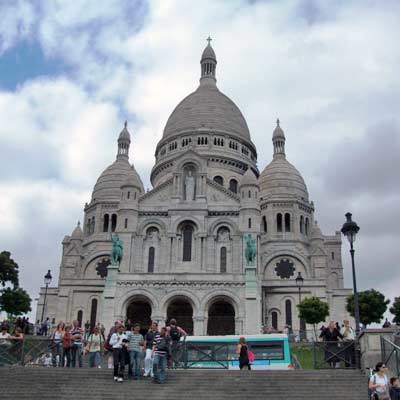
The Sacré-Cœur provides one of the finest view of Paris

House of the Blackheads in Riga
Hop between the charming plazas and Art Nouveau neighbourhoods of Riga with help from this curated itinerary. It lasts two days and includes most of the mainstream sights and some hidden extras for good measure:
Day 1: Breeze straight into the Riga Old Town. This medieval maze of a district is a fairy-tale place to be. It's also got a glut of sights. Start on the square topped by Saint Peter's Church. The oldest Christian building in the city, it's been rebuilt and reconstructed many a time.
You can scale the 120 or so metres to the top of the spire to get 360-degree views of the river, the capital, and even the Baltic coast. Back on ground level and a few streets over, you can see beautiful Town Hall Square. The most eye-catching building in the city looms on one side.
It's the so-called House of the Blackheads, where rich bachelor merchants held court for several hundred years. Delve inside for exhibits that unravel the enthralling past of the city since the age of the Hanseatic League.
Move northwards through Dome Square to have sunny lunches under the handsome cathedral building. Then push on to Riga Castle. First raised in 1330, it's gilded with additions that were built by the Swedish invaders of Latvia.
As evening closes in, you could opt to join the famous Riga Pub Crawl. They hit a number of underground Latvian taverns and then a pumping club.

The cobbled streets of Riga’s old quarter
Day 2: Hangover or not, you should rise early and make for the western area of Miera Iela. The cracked-plaster façades of the old buildings there herald what's surely the most hipster and creative corner of the city. Students and young professionals are everywhere, and there are some top brunch spots to kick start your morning. Then bear eastwards, back towards the Old Town.
On the way, you'll have to navigate Centrs district. Your first pitstop should be Alberta 12, where a grand edifice decorated with statues of nymphs and floral motifs commands the attention. It's one of the finest examples of the Art Nouveau style for which Riga is famous. Inside, you'll even find the Riga Art Nouveau Museum, which chronicles the architectural and design style from the turn of the century onwards.
Lunch can be had in the new town area to the south – Dzirnavu Iela especially has some charming café-bars and great shopping. The pretty walking paths of Vermane Garden can be perfect for an afternoon stroll if the sun is shining. They will take you all the way to the vibrant Pilsetas kanals garden, the home of the town's padlock-covered love bridge that's in good proximity to some hearty Old Town taverns for dinner.

The freedom Monument – the three stars represent the three regions in Latvia

The Art Nouveau on the Alberta 12
Paris in 48 hours is a hard ask, but this itinerary should help distil the city's preeminent culture, art and atmosphere into two short days:
Day 1: Breakfast time in the 19th arrondissement. Local and traveller joints meet there, with some charming cafés and bakeries lining Le Bassin de la Villette, where there are open-air swimming spots in the summer months. Then, move south-west along the picturesque Canal Saint-Martin.
It takes you to the beating heart of the city, just shy of where the Île de la Cité hosts the beautiful Cathedral of Notre Dame. Take your photos and then move across the Seine River to the famous Latin Quarter.
It's the perfect place to explore in the afternoon, with boutique bookshops and atmospheric cafés aplenty. For the afternoon, cross the water again and duck into the Louvre Museum.
The morning rush should have subsided, so you can wander the exhibition rooms in search of the Mona Lisa and the Venus de Milo without having to jostle with too many. In the evening, return westwards to hipster Belleville. This district is one of Paris's Chinatowns, with more noodle shops and dim sum outlets than you can shake your guidebook at.
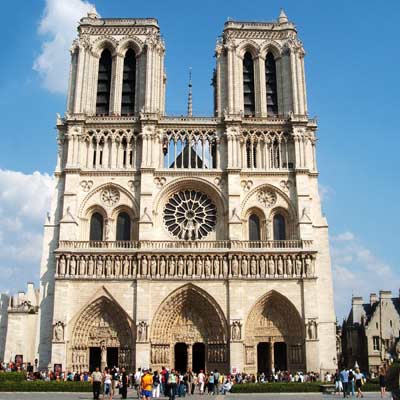
Notre-Dame
Day 2: Seek out the bohemian neighborhood of Montmartre to start your second day in Paris. It's known for its zigzagging cobbled streets and urban staircases, but also comes replete with cosy coffee houses with crispy croissants. At the very top of the hill where the district is draped is the gorgeous Sacré-Cœur. Its great travertine domes gaze over the city, so expect some awesome views.
On the way down, heading west, you might just pass by the infamous Moulin Rouge and its makeshift windmill all lit up in red neon. You can catch a metro from that to go along to Ternes. Emerge and you'll be looking straight down at the Arc de Triomphe, which marks the start of the Champs-Élysées – a place to shop till you drop.
Be sure to pull yourself from that grand boulevard with enough time (and light) left to see the Eiffel Tower in all its glory. The landmark is just over the river to the south, but the best view might be from the Trocadéro Gardens on the northern banks.
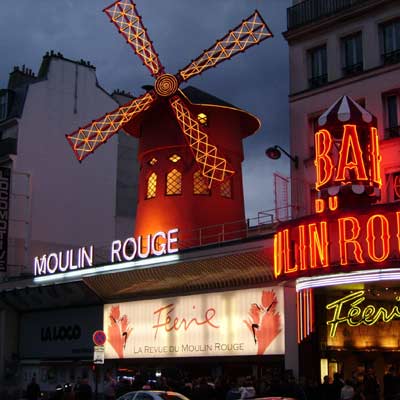
The Moulin Rouge
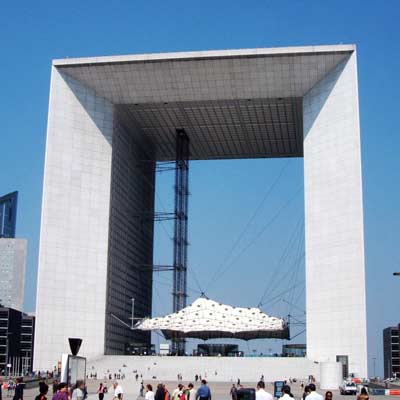
La Défense is the modern side to grand Paris
Riga
Riga International Airport is the largest in all of the Baltic states. It's served by flights originating all over Europe, in Russia, and even the Middle East. Bus 22 and plenty of private taxi firms offer connections to the city, though you'll need to be wary of scam drivers who often crank up the price to €80 or more! The trip to the downtown from the terminals usually takes no more than 30 minutes.
You shouldn't need to deal with any public transport on a city break to Riga. The town is nice and compact, so a good pair of shoes and a willingness to walk is usually enough to get around. That said, there are streetcars, buses and minibuses on the same network. Grab yourself an e-talons ticket to use the lot. Each ride costs €1.15 and needs to be renewed if you transfer.
You'll almost certainly want to seek out a hotel in Riga Old Town. That will put you right in the thick of the action. We'd recommend steering clear of Audēju Iela, though.
It's vibrant and lively, but the pumping bars can make it hard to sleep at night. Quieter areas include the northern portion of the district and the streets around Riga Castle.

Riga castle is official residence of the Latvia President
Keep your guard up when walking around Riga, particularly after dark or a few beers. The capital is generally safe, but areas like Maskavas Forštate should be avoided. Pickpockets and petty theft, along with taxi scams, tend to be the biggest dangers of all.
Paris is served by two large international airports. Low-cost carriers typically use Orly. From there, you can hop to Anthony Train Station and then switch to the urban metro line to reach the city. The trip costs around €12 in total. The more famous and larger airport at Roissy Charles de Gaulle is for long-haul fliers and premium services. It's linked straight to the Gare du Nord station in the middle of the city by regular trains that take around 35 minutes from terminal to town.
Choosing the right area to stay in Paris is important because each arrondissement has its own distinct vibe. You can pay extra and be somewhere like Grenelle and the 7th, where you're most likely to open your hotel window and be gazing at the Eiffel Tower. Or, you can opt for a B&B somewhere like the Canal-Saint Martin – a vibrant, student favourite – or in the 11th arrondissement – cheaper and more lived-in.
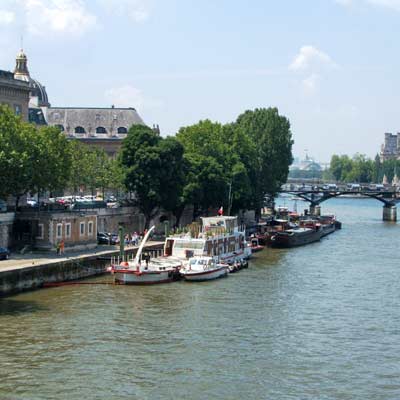
The Seine River meanders through the centre of Paris
The Parisian transport network is vast and efficient. Travelers shouldn't need more than the RER and Metro combination. They can be caught to virtually all the major sights and areas around the capital. You can purchase a contactless card ticket to travel on all the lines – tariffs are €1.90 per ride.
Even among the French themselves, the Parisian people are renowned for being curt and a little rude. Remember that this is a working, living metropolis, so expect central areas to be busy with commuters and the like. You'll also want to be especially cautious on public transport when carrying large luggage or travelling at night, because pickpocketing and thefts certainly aren't unheard of.

oh we were stuck in the airport!

Copenhagen was a bit expensive...

All we did was drink beer in Brussels...

Muncih was crazy

And we got so burnt!

Remeber that night in Rome

oh we were stuck in the airport

So much fun kayaking

Berlin and that group from Austria!

There was such a view from that church

And we got so burnt!

Munich was eventful, wasn't it!

Such a view from that cathedral in Florence

Lisbon was such so much fun

Last summer was so much fun .... x

Remeber that night in Rome

Lisbon was such so much fun

Such a view from that cathedral in Florence

Munich was eventful, wasn't it!

And we got so burnt!

Remeber that night in Rome

All we did was drink beer in Brussels...

Berlin and that group from Austria!

Can't wait to go back to Dubrovnik

Remember that boat ride in Prague

Copenhagen was a bit expensive...
